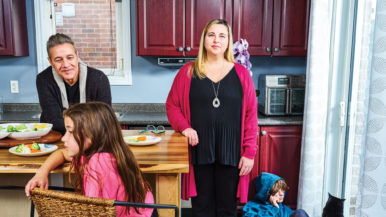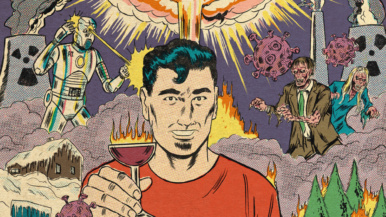The Way We Eat Now: Toronto’s love affair with a new generation of innovative butchers

Like a good dealer, Peter Sanagan knows how to move product. Three years ago, he got me hooked on beef cheeks, once a hard-to-sell offcut destined for sausage mix. He promised the suppleness of a brisket and the marbling of a striploin. All I had to do was lovingly braise them.
Thing is, he was right. Unlike a thick, juicy rib-eye, which sells itself, cheeks aren’t a piece of meat you toss on the barbecue in the heat of July. They’re something you cook during the long, cold winter, simmering them slowly in a pot of stock and vegetables, coaxing out their flavour, melting their collagen into smooth gelatin. At the time, I’d never encountered beef cheeks, but today they’re on menus all over the city. Demand for unusual cuts has skyrocketed in recent years, thanks to sly merchants like Sanagan, who buys well-raised whole animals and hires professional cooks to break them down and sell their parts at his Kensington shop, Sanagan’s Meat Locker.
Though he failed to turn me onto pig cheeks (too small, about a bite-size Snickers’ worth of meat), Sanagan has moved me from indulgent rib-eye to sensible bavette. He’s sent me home with goat necks, oxtails and a pig head, sliced in half to fit in my non-restaurant oven. After brining the head in saltwater, steam-braising it for six hours and then broiling it until the skin was sticky and the ears crispy, I served it to my dinner guests with Harbord Bakery bagels, dijon mustard and home-pickled pearl onions. The snout was like candy. The head fed a dozen people. It cost five dollars.
My butcher has talked me through my first Christmas capon. He’s answered my early morning emails about brining ratios (a cup each of salt and sugar to four litres of water; six hours for a chicken, overnight for a turkey or capon). When I couldn’t get the right texture for confit rabbit rillettes, he tipped me off that finishing the meat in my KitchenAid with the paddle attachment made it sublimely spreadable on toasts.

Sanagan’s tips are always spot-on because he’s a chef—he spent years running the kitchen at Mistura. He’s hired a skilled crew and makes sure they’re fully informed about the meat they’re selling—how it was raised, what it was fed—and ready to dole out advice on how to cook it. When confused customers ask for “a roast,” the staff help them figure out whether a showy prime rib or simple pot roast (i.e., clod or shank) is in order. They’re trained to say “yes” to just about any request: cutting oxtail Jamaican-style (through the bone), removing the nipples from pork bellies. An axiom of the modern butcher shop is that it’s easier to teach a cook customer service than to teach a sales clerk how to cook.
When I was a kid, we bought meat on slips of Styrofoam wrapped in plastic. We chose it based on the expiry date and the colour, thinking it had to be bright red. We didn’t know that fatty, marbled, pink-and-white beef is far more delicious than monochromatic lean meat. There were butcher shops, too. But the burly old grumps who ran them hollered at you when you got to the front of the line and didn’t know what you wanted.
The new Toronto butchers have very different ideas about product and service—namely that every part of the animal be sold (not just in sausages) and that a burning passion for good food be used to connect with customers. And they’re sprouting around the city like Starbucks. From Royal Beef in the east end to Butcher by Nature in the west to the halal Paramount Butcher Shop in Mississauga. In the past year, half a dozen new shops have hung out their shingles.
It all started in 1994 when Stephen Alexander launched his first Cumbrae’s outpost on Church Street. He paid attention to things like eye size, muscle fibres (finer for grilling meats, thicker for slow-cooking) and marbling to help us understand meat in a new way. He taught Toronto carnivores that beef could have complex flavours, including grass and mushroom, hitting the tongue in succession like a good wine. He also converted us to dry aging, with its funky smell and flavour notes of blue cheese, prosciutto and brown butter. Before Alexander, the idea that beef should sit untouched for 30 days until it was covered in mould would have induced nausea. We now know that it makes for an awfully appetizing bite. He’s opening his fourth shop this spring.

Thanks to Cumbrae’s, no one sells just meat anymore. Butchers double as caterers, wholesalers, purveyors of fancy salts and mustards. Bones are boiled for stock, stacked in half-litre containers in a display freezer. Every imaginable scrap is transformed into sausages, terrines or ready-to-eat pot pies, serving every corner of the market from adventurous home chefs to frazzled nine-to-fivers.
The 2008 recession was a huge catalyst for the ascent of butchery. I was a dining critic with the Star at the time and saw high-end restaurants become ghost towns overnight. Instead of waiting for the bottom to fall out, young cooks struck out on their own, opening the inventive 50-seat spaces that have redefined Toronto’s restaurant landscape. They began jamming wildly inexpensive, unloved cuts of meat—pig tails, veal tongue, cockscombs—into charcuterie. Diners loved it and went to the experts—butchers—to recreate the experience at home. Butchers have become our liaisons to the chef world. They can tell us how to make the chicharron the restaurant served last night because, likely, they used to work at the place.
These new shops are impeccably designed, lit and ornamented, ready for their Instagram close-ups. Olliffe’s owners, the Gundy brothers, hired interior designer Brad Denton (known for creating sexy, shadowy restaurants) when they renovated their Rosedale meat emporium in 2009. The beef aging chamber was put on display, and out front, Denton opened up the space to allow customers to watch butchers cleaving flesh from bone, separating a whole lamb into hindquarters, loin, shoulder and neck in front of a gleaming white-tiled wall. When you see the animal being turned into chops, it’s impossible to pretend that meat is magically manufactured in antiseptic rectangles.
Ossington’s year-old Côte de Boeuf, from Union chef Teo Paul, is as curated as a Wes Anderson set. The glass cabinet is filled with neatly labelled duck à l’orange, lobes of foie gras, terrines of headcheese or rabbit with black trumpet mushrooms, all laid out on red-and-white-checkered paper. Rope lights illuminate Quebec butter, farmers’ eggs, quince jam. Under a tin ceiling, a chalkboard lists the suppliers: Scotch Mountain Meats in Meaford, Blue Haven Farm in Rockwood.
I recognized Blue Haven’s name from my visit there a few years ago, when co-owner Marcia Stevers told me the names of her sows, Patsy and Anize, as she hugged their piglets. The little guys were just about the size of the face I ate on bagels. As the livestock frolicked in the snow, Stevers made me a bowl of her pea soup, brimming with pork hocks. It was confirmation, for me, that it’s possible to have affection for animals and eat them. A good butcher will balance mercy with heavenliness on the tongue.
When I first moved into Kensington in 2006, before the meat revolution, I tried to befriend my butcher. I went into the tiny, nearly empty shop and asked the man behind the counter if he had tenderloin for tartare. “Nope,” he said, refusing to look up from his newspaper. We did not become pals. In the neighbourhood’s larger shop—space Sanagan’s now occupies—I tried asking, “What’s good today?” They looked at me like I’d just asked for a lift to the airport.
These days at the butcher shop it’s their favourite question. They ask if I want my pork shoulder bone-in and skin-off (I do), what I plan on doing with the pint of blood I ordered (boudin noir). Before I go in, I consult a cheat sheet of staff names, labelled “Beardo, Nose Ring, Redhead, Manager, Beardo No. 2.” I like hanging out at the old deli counter while waiting for my meat to be trimmed. The former tenants sold inedible reheated burgers; Sanagan offers gourmet sandwiches: jerk pork with jicama slaw, roast beef with mushroom gravy.
The butcher-buyer relationship has become a new status symbol. I had one dinner guest boast of the wagyu steaks his butcher brought in just for him, another who confessed his eagerness to learn about meat to earn his butcher’s approval. It’s taken our neighbourhood pride to a new level—people challenging the quality of their butcher shop over others’. (Residents of the Junction or Roncesvalles like to brag about Gourmeats or Custodio’s.) Soon enough, proximity to a good butcher will factor into property values the same way good schools and subway access do.






Nice Piece.
Like :-) I’m a fan of my local butchers and the St. Lawrence market, where I can get some offcuts that I’m not seeing locally. After reading The Belly of Paris, I want to try making a boudin noir. Please publish your recipe, Corey!
Royal Beef – in the East End didn’t or hasn’t just sprung up – it has been there for over a decade – hell, perhaps two by now. As for Cumbrae – try and get anything halal there – nope don’t bother. There are so many people in the city that are eating halal now yet none of these or few of these sell halal meat – why is that? Why shouldn’t I be able to get halal quality meat at Cumbrae in the village – why should I have to go further afield? I see they are opening a fourth shop – let’s hope it is in an area where no one is going to want halal. I am disappointed in all this meat talk to only a specific audience.
Just because you believe in fairies doesn’t mean the rest of us have to. If you want an article about Halal why don’t you write it? If you have a halal butcher who can hold a candle to these guys … speak up! This is obviously about the new generation of butchers who know how to get the most of their meats … shop there if you want to … if not, ask your halal butcher to take a few notes from these guys
Having moved to a rural place, I soon learned that the local butcher (Alvinston Abattoir ) will cut to order and save offal parts for me. Custom smoking and sausages too. Exceptional ham steaks.
However, the standard farmers cuts in small town shops are old fashioned and need updating for current lifestyles. Thin steaks and chops, weird cuts like the steak roast, and too much sausage or ground beef from the sides that most people buy, all of them designed for intense, hard working farmers’ dinners, using up most briskets, flanks, skirts, cheeks, tails etc.
Cumbraes and Sanagan may have reinvented the butcher shop, but old ways die hard at most shops or abattoirs, and supermarket butchers are cutting from boxed meat now, with little regard for offal or sub prime cuts. Word moves slowly, and many customers are ahead of the trade.